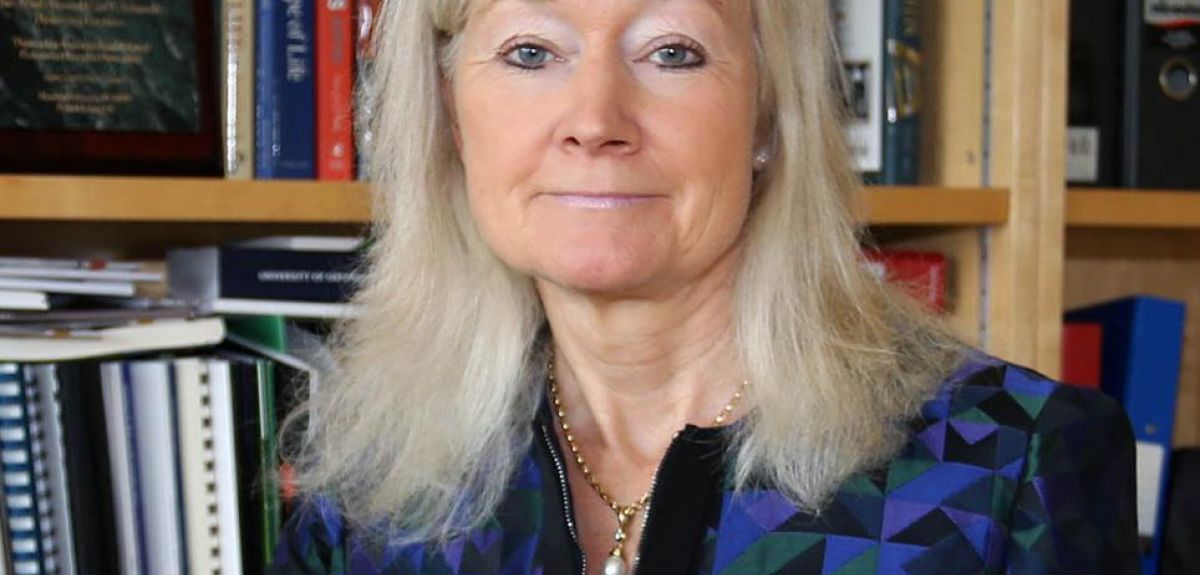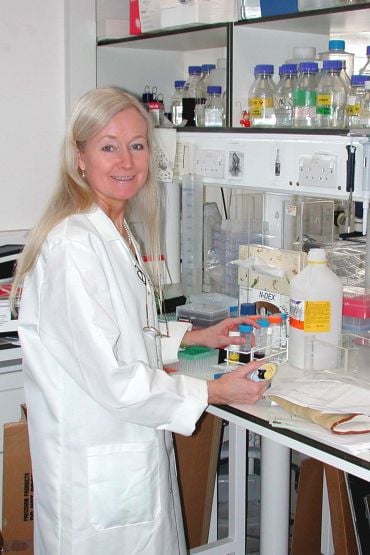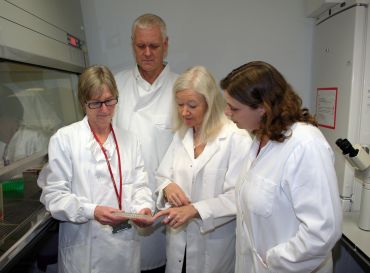
Not a tea lady: The prime of Professor Dame Kay Davies
In spite of everything, many people still underestimate women, in general, and older women, in particular. They have clearly never encountered Kay Davies, the dynamic 70-year-old Oxford geneticist, who is ‘retiring’ after a lifetime’s research (but not really). Just a few minutes immersed in the company of the self-effacing-but-determined Professor Dame, is enough to make anyone exhausted and put paid to stereotypes about women.
Forget about older women being invisible, you could not miss Professor Davies, who arrives promptly for her interview, lovely in a hallmark brightly coloured jacket
Forget about older women being invisible, you could not miss Professor Davies, who arrives promptly for her interview, lovely in a hallmark brightly coloured jacket (more of which later).
But the professor’s story is even more arresting than her striking appearance. Having arrived in Oxford more than 50 years’ ago, Professor Davies has worked with some of the leading medical scientists of the last half century.
She has been tirelessly at the cutting-edge of genetic science; is close to a cure for a devastating genetic condition – and has found time to be a member of the Council of the Medical Research Council, Deputy Chair of the Wellcome Trust and hold a variety of other posts. Professor Davies has been honoured in the UK (a CBE, followed by a DBE in 2008) and in the US (by the American Society of Human Genetics) – oh...and she has a family.
Being a mother makes you well organised,’ laughs Professor Davies, with typical modesty.
That’s true, of course, but there’s well organised and well organised
‘Being a mother makes you well organised,’ she laughs, with typical modesty. That’s true, of course, but there’s well organised and well organised.
‘I am highly organised,’ Professor Davies admits. ‘Having a child makes you more organised. They come first and you arrange things around that. Mothers achieve so much.’
Professor Davies talks passionately of a lifetime spent researching a cure for Duchenne muscular dystrophy, a devastating genetic condition. Duchenne, which strikes boys, affects one in 100,000 globally and sees sufferers confined to a wheelchair, on average, by the age of 12 and rarely surviving their late 20s.
Professor Davies talks passionately of a lifetime spent researching a cure for Duchenne muscular dystrophy, a devastating genetic condition
It has been a labour of true dedication and many many hours in the lab. Having spent decades on genetic research into the condition, Professor Davies hopes there will be a cure within five years. In fact, she says firmly, she is not going to stop until one exists and, listening to her, you just know, she is going to do it – or someone else.
‘It’s been my life,’ she says. ‘I won’t retire until a cure is found.’
Professor Davies was researching genetic treatments when people still thought histone proteins were on the outside of DNA (they’re not) and she has followed the science through to a place where they are now tantalisingly close to major breakthroughs.
It’s been my life...I won’t retire until a cure is found
Professor Kay Davies
It has been a long journey for the clever girl from a state school in Stourbridge, who came to Oxford at the end of the 1960s to study Chemistry (which she did not really like very much) and then switched to Biochemistry.
It had been a very good all-girls school, she says, with an ‘extremely good’ Chemistry teacher. But the young Kay had not been able to take Biology, because, in those days, you needed Latin to go to Oxford and she could not take both.
‘I was never any good at languages,’ she says. ‘But I was good at Maths. I loved problem solving, which is why they probably accepted me.’
Arriving at Somerville, straight out of school, when many people then took the Oxbridge exam and applied post-A levels, she was among the youngest in her year – and one of the very few women. Although she had plenty of drive, she says, although it was a difficult start: she was ‘shy and not very confident’.
‘There were only a few females doing Chemistry,’ she says. ‘I was the only person from a state-funded school and one of the few from a working class background.’
She laughs, ‘I had something of an inferiority complex, although I was able to do the subject. I had drive, though, I probably got that from my mother. She had a lot of drive.’
I learned style from Mary Archer [a tutor at Somerville], but a lot else as well...I learned to be more ambitious and adopt a can-do attitude
Professor Davies
Oxford’s tutorial system helped the young scholar set aside her reserve. She says simply, ‘It was very competitive. But I found I was surrounded by amazing women.’
The then very young Mary Archer was a tutor at Somerville, ‘She was very driven and meticulously dressed, so stylish and intelligent.’
Professor Davies laughs, ‘I learned style from Mary Archer, but a lot else as well.’
‘I learned to be more ambitious and adopt a can-do attitude,’ she says.
 Kay Davies: last day in the lab.
Kay Davies: last day in the lab.Oxford was a very different place in those days, she says, clearly full of enthusiasm about the way the university has changed, ‘It’s a lot more collaborative now than in the 70s. There’s such a buzz now...there are links between the medical sciences and other sciences and the whole thing functions much better.’
It is evidently a heart-felt sentiment. One of the key threads in the professor’s career has been her cross-disciplinary work – which began when she swapped Chemistry for Biology and medical sciences. After completing undergraduate degree, Kay took a DPhil in the very new study of the structure of genes. After completing her doctorate, Professor Davies went to Paris where her husband, later an Oxford professor of Chemistry, had a position.
Dr Davies commuted to London to work in a laboratory at St Mary’s hospital – just near Paddington station.
She says. ‘I got off the train at Paddington and went straight into the lab.’
Though still a young researcher, she worked with some of the pioneers of genetic research. At St Mary’s, she worked for Professor Bob Williamson, the distinguished British geneticist. It was ‘so exciting’, she says, but the cross-country commute was a bit much, even for Kay Davies.
Why Duchenne? Because it affects boys, so we could narrow down where we were looking for the gene, says Professor Davies
But finding and isolating the gene has not been simple
It took an intervention from the Nobel Laureate, genetic code specialist Professor Sydney Brenner, to suggest her return to Oxford. He clearly spotted something in her and decided she should be encouraged. In the days before HR, he picked up the phone and called Oxford.
‘He told them I should have a place...So I moved my fellowship to Oxford in 1984,’ she says.
Whilst in London, Professor Davies alighted on Duchenne. Why Duchenne?
‘Because it affects boys, so we could narrow down where we were looking for the gene,’ she says simply. But finding and isolating the gene has not been simple.
It has needed ‘tenacity and patience’, admits Professor Davies.
 Kay Davies with, left to right: Ally Potter, Dave Powell and Angela Russell
Kay Davies with, left to right: Ally Potter, Dave Powell and Angela RussellIn the event, the gene was found by others and it was ‘very large in the genome sequence’. Then a breakthrough came when a patient in Birmingham was found – who had just 50% of the gene. He had only just been diagnosed and had lived, although he had a milder version of Duchenne, into middle and then old age.
It offered considerable hope for sufferers – if only they could remove part of the gene, replicating the man’s variation. Since then, others have come forward with similar mild symptoms, says Professor Davies, who has become close to many families and charities involved in the debilitating condition.
It needs more screening of molecules for our approach to therapy...We screen a lot of molecules with the help of Angela Russell’s group in Chemistry. And we might end up curing those boys
Professor Davies
‘As a team, we’re very committed,’ she says.
They have to be. Finding a way to change the gene, for those with full-blown Duchenne was never going to be easy. Sufferers are living longer now, thanks to better treatments, but few live to see their 30th birthday.
‘It needs more screening of molecules for our approach to therapy,’ she says. ‘We screen a lot of molecules with the help of Angela Russell’s group in Chemistry. And we might end up curing those boys.’
The gene therapy treatment could also be potentially used to treat other forms of Muscular Dystrophy, Professor Davies says with real passion.
And that’s the key, she says, Passion, ‘This isn’t work...you have to do what you’re passionate about and it will work out. And don’t feel bitter when people knock you back.’
It’s an important thought because, on many occasions during her career, she has been the only woman in a room of dark-suited men. Professor Davies laughs as she says she was occasionally mistaken for a tea lady, ‘You can’t feel bitter about it, that’s why I buy bright jackets. No one mistakes me for a tea lady anymore.’